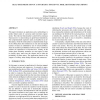954 search results - page 114 / 191 » Principles and Models for Organizing the IT Function |
ICWE
2005
Springer
14 years 1 months ago
2005
Springer
We present the design of a new web application framework for collaborative learning. The framework guides users (i.e. teachers) in implementing online activities based on well-know...
ICCBSS
2004
Springer
14 years 1 months ago
2004
Springer
In this paper we propose a taxonomy for classifying COTS business applications, i.e. products that are used in the daily functioning of all types of organizations worldwide, such a...
ECAI
2006
Springer
13 years 11 months ago
2006
Springer
In a peer-to-peer inference system, there is no centralized control or hierarchical organization: each peer is equivalent in functionality and cooperates with other peers in order...
WSC
2007
13 years 10 months ago
2007
This paper introduces an application and a methodology to predict future states of a process under real-time requirements. The real-time functionality is achieved by creating a Ba...
ISMB
2000
13 years 9 months ago
2000
We present a computational approach to predicting operons in the genomes of prokaryotic organisms. Our approach uses machine learning methods to induce predictive models for this ...

